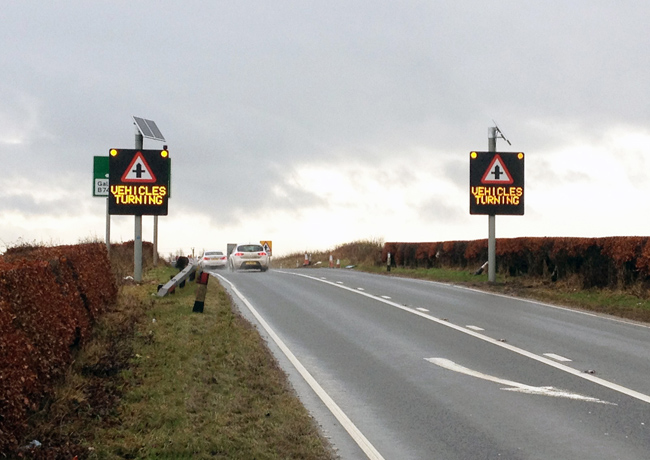
Hitting an animal on a rural road can be fatal for all parties involved – but detecting and avoiding them requires clever technology. Andrew Williams carefully scans the horizon for details
Wildlife-vehicle collisions are an ever-present threat in rural areas around the world, and there is certainly nothing funny about suddenly finding an angry moose in your headlights on a sharp bend. A variety of detection and avoidance systems are currently in use or under development to help prevent your vehicle being turned to scrap and an innocent creature to mincemeat.
One of the early frontrunners in this field is Canada-based company AUG Signals, which has developed the LADS (Large Animal Detection System) that uses a 360-degree scanning radar to monitor moving objects within a 700m radius.
“Using a radar gives LADS extended operating range, superior performance in extreme weather and low maintenance costs,” says Abir Mukherjee, systems architect at AUG.
LADS was conceived over five years ago to mitigate wildlife-vehicle collisions for the Ontario Ministry of Transportation (MTO). To begin with, two units were installed on Ontario Highway 416 outside Kemptville - with further installations in Mount Revelstoke and Glacier National Park, British Columbia, as well as outside Canada – in Estonia and India - since then.
Detection warning
According to Mukherjee, the company’s proprietary algorithms detect, track and classify objects to filter out background noise, and detect large animals within ‘user-defined monitored zones’. A warning is issued when an animal is detected, which remains active for as long as the animal stays within one of the monitored zones. All trajectories of moving objects can also be recorded for post-analysis and review, and remote access is possible with a network or internet connection, enabling live feeds from sites and remote diagnostics for troubleshooting.
“In our deployments, LADS has been coupled with amber traffic lights to warn motorists,” says Mukherjee. “These lights are controlled over wireless radio links, and flash while animals are present on - or near - the roadway. Alternative forms of alert notification, such as audio, email or SMS are also possible.”
According to past studies, there are somewhere between four and eight wildlife-vehicle collisions every hour in Canada and - factoring in injuries, fatalities and damages - these incidents are estimated to cost in the region of CAN$200 million a year.
“Intelligent transportation systems are becoming increasingly common for roadside applications,” Mukherjee continues. “There is increased adoption by transportation authorities looking for operational efficiencies. Internet of Things (IoT) technologies have also helped by enabling easier access to disparate data derived from heterogeneous sources.”
These technologies are expected to become more affordable as they mature, he adds. “We anticipate greater adoption of IoT-based technologies into ITS systems, and possibly autonomous vehicles with V2X [Vehicle-to-Everything] technologies, for autonomous operation in rural areas over the next few years.”
Cascade classifiers
Another innovative system has been developed by a research team at the University and Institute of Advanced Research (UIAR) in Gandhinagar, India. The system employs a computer algorithm, similar to the type often used to detect people in video footage, alongside a boosted set of so called ‘cascade classifiers’ - which are used in facial recognition software. A simple dashboard camera collects live video of the road ahead and the algorithm searches for signs of animals in the frames. The algorithm then detects whether an object is an animal and, if so, calculates the distance of the animal from the car based on its size and the vehicle’s speed. If necessary, the system then alerts the driver to decelerate or brake. So far, videos have been taken using a camera with a frame rate of 30fps mounted on a testing vehicle.
As Dr. Sachin Sharma, assistant professor at UIAR, explains, India has the second-largest road network and the highest number of road accidents and fatalities in the world. “While its people continue to become richer and acquire more cars, these incidents are likely to rise,” Sharma says. “Over 1,500 accidents involved an animal in 2015-2016, a figure that has increased to more than 2,000 in 2017. The situation has not improved due to the increase in the number of vehicles and also due to the absence of any intelligent highway safety and security system in cars or roads.”
To date, the system has been tested on video footage featuring 600 animals and the algorithm achieved a detection rate accuracy of approximately 82%, with a low false-detection rate. According to Sharma, training and testing the system on larger data sets with different angles and weather conditions will further improve the detection rate.
“If we look at the solution which is available in the developed countries, they are really costly,” he continues. “So we need to have something which is low-cost and you can replicate again anywhere in the world. Detecting animals on highways is a very complex area. Though the basic shape and size of a human being is pretty average and standard, the same is not true for animals.”
Computer vision image processing with the introduction of deep learning and advanced sensors could help a lot in reducing the number of animal-vehicle collisions both during daytime and night-time in future, he adds.
Infra-red sensors
Meanwhile, another team in Brazil is in the early stages of developing another system, dubbed the Brazilian Animal Detection System - Passa-Bicho. Fernanda Abra, founder of road traffic mitigation outfit ViaFauna, explains that the system uses active infra-red sensors to detect animals approaching the highway. Once an animal is detected, warning signs are activated to signal its presence on the highway to users, prompting them to slow down and become more alert in an effort to avoid collision.
The team has recently completed a functional prototype of the system - and Abra confirms that controlled trials will begin in rural areas with domestic animals like cows, horses, dogs and goats next year.
“This phase aims to test the efficiency of the system’s detectability for different animals, as well as to test its exposure to rain, heat and other climatic variations. The final test phase will consist of the installation of the equipment on a real highway for adjustments of the equipment and transmission of the data,” she says.
Brazil is known for its rich biodiversity, but animal-vehicle collision is a serious challenge for the conservation of several species, especially endangered ones, as well as a problem for driver safety.
In the state of São Paulo, almost 24,000 road accidents were caused by animals between 2005-2013. In recent years, Abra points out that statistics have also shown an increase in animal-vehicle collisions throughout Brazil, both due to the increase in reports and the number of new highways or upgrades in rural areas.
Roadkill studies
Dr. Molly Grace, a Natural Environment Research Council (NERC) knowledge exchange fellow in the Department of Zoology at the University of Oxford, has taken part in roadkill studies along two rural roads, State Road 40 in Central Florida and US Highway 41 in South Florida. Her team found that, in just two years along a 4.5-mile stretch of the SR40, nearly 63,000 animals were killed: more than 95% of these were frogs and toads - but several were severely endangered Florida panthers.
“It was absolute carnage,” says Grace. “Most people would never even notice running over a frog, but the scope of the problem is immense, especially during the rainy months when frogs are actively searching for mates. Since 2000, collisions with panthers have been steadily on the rise: from less than 5 per year to nearly 30 per year, and the rate keeps increasing. Though that may not sound like many individuals, consider that best estimates indicate that there are less than 250 panthers left, and roadkill is the leading cause of death for this endangered animal.”
Grace has both studied and tested a variety of roadside animal detection systems, which she believes represent an innovative and potentially cost-effective approach to preventing crashes.
“Essentially, they work by sensing animals near the road, traditionally with infrared or microwave sensors installed along the roadside, and alerting drivers in some way,” she explains. “Andrew Alden and his team at the Virginia Tech Transportation Institute is taking this further by working to develop techniques that would send the warning directly to cars nearby, making use of advances in the standard technology being installed in cars.”
Grace also highlights the work that Volvo is undertaking to enable cars to detect large animals using radar and automatically slow or stop in order to reduce or minimise a collision.
“If it takes off and is truly effective, this would solve the problem we currently have that we can’t install animal detection systems along every mile of road in the world. The technology would travel with drivers wherever they go, which I think would be really helpful,” she concludes.










